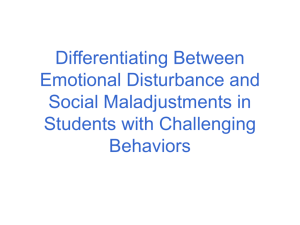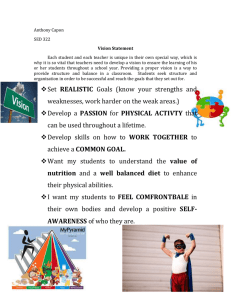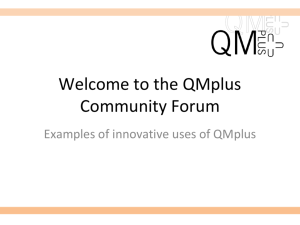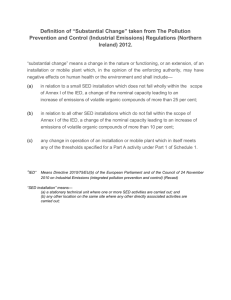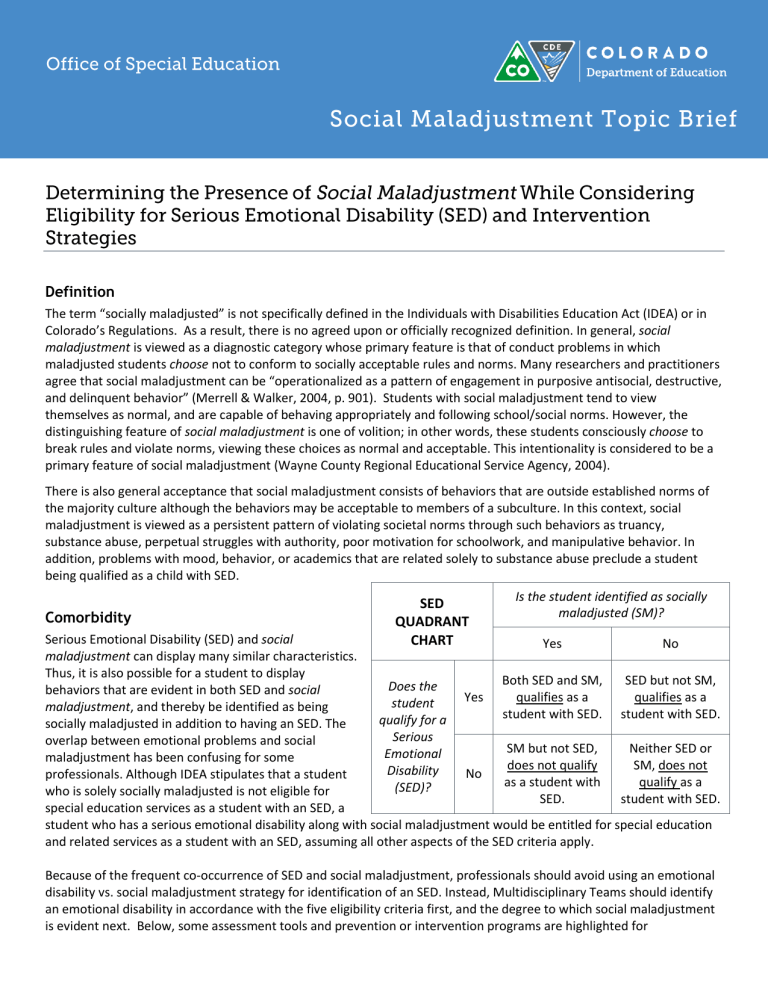
Definition The term “socially maladjusted” is not specifically defined in the Individuals with Disabilities Education Act (IDEA) or in Colorado’s Regulations. As a result, there is no agreed upon or officially recognized definition. In general, social maladjustment is viewed as a diagnostic category whose primary feature is that of conduct problems in which maladjusted students choose not to conform to socially acceptable rules and norms. Many researchers and practitioners agree that social maladjustment can be “operationalized as a pattern of engagement in purposive antisocial, destructive, and delinquent behavior” (Merrell & Walker, 2004, p. 901). Students with social maladjustment tend to view themselves as normal, and are capable of behaving appropriately and following school/social norms. However, the distinguishing feature of social maladjustment is one of volition; in other words, these students consciously choose to break rules and violate norms, viewing these choices as normal and acceptable. This intentionality is considered to be a primary feature of social maladjustment (Wayne County Regional Educational Service Agency, 2004). There is also general acceptance that social maladjustment consists of behaviors that are outside established norms of the majority culture although the behaviors may be acceptable to members of a subculture. In this context, social maladjustment is viewed as a persistent pattern of violating societal norms through such behaviors as truancy, substance abuse, perpetual struggles with authority, poor motivation for schoolwork, and manipulative behavior. In addition, problems with mood, behavior, or academics that are related solely to substance abuse preclude a student being qualified as a child with SED. Comorbidity SED QUADRANT CHART Is the student identified as socially maladjusted (SM)? Serious Emotional Disability (SED) and social Yes No maladjustment can display many similar characteristics. Thus, it is also possible for a student to display Both SED and SM, SED but not SM, Does the behaviors that are evident in both SED and social Yes qualifies as a qualifies as a student maladjustment, and thereby be identified as being student with SED. student with SED. qualify for a socially maladjusted in addition to having an SED. The Serious overlap between emotional problems and social SM but not SED, Neither SED or Emotional maladjustment has been confusing for some does not qualify SM, does not Disability No professionals. Although IDEA stipulates that a student as a student with qualify as a (SED)? who is solely socially maladjusted is not eligible for SED. student with SED. special education services as a student with an SED, a student who has a serious emotional disability along with social maladjustment would be entitled for special education and related services as a student with an SED, assuming all other aspects of the SED criteria apply. Because of the frequent co-occurrence of SED and social maladjustment, professionals should avoid using an emotional disability vs. social maladjustment strategy for identification of an SED. Instead, Multidisciplinary Teams should identify an emotional disability in accordance with the five eligibility criteria first, and the degree to which social maladjustment is evident next. Below, some assessment tools and prevention or intervention programs are highlighted for 2 informational purposes. The items highlighted below are neither exhaustive, nor are they recommended or endorsed by the Colorado Department of Education. Evaluation The Common Characteristics chart on the opposite page is proposed as a guide for school professionals to determine whether social maladjustment is present. These characteristics should be evidenced by formal and informal assessment data from a variety of sources. The list below represents assessments that are widely used in the field and may be used as part of a body of evidence to determine the presence of social maladjustment. • • • • • Behavior Assessment System for Children, Third Edition; BASC-3 (Reynolds and Kamphaus, 2015) Conners Comprehensive Behavior Rating Scales; Conners CBRS™ (Conners, 2008) Conners, Third Edition™; Conners 3™ (Conners, 2008) Emotional Disturbance Decision Tree; EDDT (Euler, 2007) Scales for Assessing Emotional Disturbance, Second Edition; SAED-2 (Epstein, 2010) Differential Scales of Social Maladjustment and Emotional disturbance; DSSMED (Ehrler, McGhee, Phillips, & Allen, 2009) Functional Behavioral Assessment (FBA) For more information on the determination of an SED as well as the interplay between SED and social maladjustment, please refer to the Guidelines for Determining Eligibility for Special Education for Students with Serious Emotional Disability at http://www.cde.state.co.us/cdesped/guidelinesfordeterminingeligibility_sed. Special Considerations Evaluations must be sufficiently comprehensive to appropriately identify all of the child’s special education and related service needs, whether or not commonly linked to the disability category in which the child has been classified (IDEA 34 CFR §300.301, §300.304 and §300.305, ECEA 4.02 (4)). Teams must also document their consideration of other suspected disability categories for students that do not qualify for SED. For example, if a student has a medical or clinical diagnosis, the team may consider the Other Health Impairment category and document this consideration. Intervention Whether a student is identified as having an SED or being More information on Multi-Tiered Systems of challenged with social maladjustment solely, educators Support (MTSS), can be found on CDE’s should identify interventions based on the individual needs webpage for MTSS resources: of each student. For both students identified with SED http://www.cde.state.co.us/mtss/resources and/or social maladjustment, Positive Behavior Interventions and Supports have been shown to be more effective than harsh or punitive consequences. A well-implemented Multi-Tiered System of Support (MTSS) can help ensure that student’s behavioral support needs are being assessed and appropriate evidence-based interventions are being provided. An example of an evidence based intervention is the The Incredible Years, a set of three interlocking, comprehensive, and developmentally based training programs for children, their parents, and teachers which has been shown to reduce child behavior problems. This program has been reviewed by the Substance Abuse and Mental Health Services Administration’s (SAMHSA’s) National Registry of Evidence-based Programs and Practices (NREPP) as an evidence based intervention that can be implemented in a school setting. For more information on this and other evidence-based programs and interventions, please go to the NREPP website: http://nrepp.samhsa.gov/Index.aspx. NOVEMBER 2015 3 Common Characteristics Social Maladjustment Serious Emotional Disability Social Relationships Peer relationships are usually intact. Often Peer relationships are often short-lived, a source of unsympathetic, and remorseless in relation to others. anxiety, and sometimes chaotic. Often a member of a subculture group that is antisocial. Tends to have difficulty in establishing or maintaining group membership. Often skilled at manipulating others. Frequently Others are often alienated by the intensity of need quarrelsome. for attention or bizarreness of ideas and/or behaviors. Conflicts are characterized by power struggles, primarily Conflict and tension often characterizes with authority figures (e.g. parents, school personnel, relationships. and police). Often displays hostility and may engage in impulsive, criminal acts. Interpersonal Dynamics Often displays positive self-concept, except in school Often is characterized by a pervasively poor selfsituations. concept. Tends to be independent and appear self-assured. Often Often overly dependent or impulsively defiant. displays charming, likable personality. Lacks appropriate guilt; may show courage or Is generally anxious, fearful, mood swings from responsibility but often toward undesirable ends; depression to high activity; frequently has generally reacts toward situations with appropriate inappropriate affect or may react to situations with affect. inappropriate affect. Often blames others for his or her problems, but Frequent denial and confusion; often distorts reality otherwise is reality oriented. without regard to self-interest. Often a risk taker; “daredevil” Resists making choices, decisions Substance abuse more likely with peers Substance abuse more likely individually Educational Performance Tends to dislike school except as a place for social School is often a source of confusion and anxiety contacts. Frequently truant Truancy related to somatic complaints Frequently avoids school achievement, even in areas of Achievement is often uneven. competence. Tends to rebel against rules and structures. Often responds well to structure in the educational setting. (Table adapted from work done by the Ventura Unified School District, Conejo Valley Unified School Districts, and Wayne County Educational Service Agency (2004)). This CDE guidance document is meant for clarification, is not legally binding, and is not to be confused with legal advice. This guidance reflects CDE’s recommendations, but Administrative Units (AUs) may have developed their own policies or procedures that differ from those described herein. Be sure to refer to your local AU’s policies and procedures through the Director of Special Education. If you are seeking legal advice, please contact your legal counsel. NOVEMBER 2015 4 References Conners, C. K. (2008). Conners Comprehensive Behavior Rating Scales. Los Angeles, CA: Western Psychological Services. Conners, C. K. (2008). Conners Third Edition. Los Angeles, CA: Western Psychological Services. Cullinan, D., & Kauffman, J. M. (2005). Do race of student and race of teacher influence ratings of emotional and behavioral problem characteristics of students with emotional disturbance? Behavioral Disorders, 30(4), 393-402. Epstein, M.H., & Cullinan, D. (2010). The Scale for Assessing Emotional Disturbance, Second Edition. Austin, TX: PRO-ED. Euler, B. L. (2007). Emotional Disturbance Decision Tree. Lutz, FL: Psychological Assessment Resources, Inc. Ehrler, D.J., McGhee, R.L., Phillips, C.G. & Allen, E.A (2009). DSSMED: Differential Scales of Social Maladjustment and Emotional Disturbance. Austin, TX: PRO-ED Kauffman, J.M. (2004). How we prevent the prevention of emotional and behavioral difficulties in education. In P. Garneer, F. Yuen, P. Clough, & T. Pardeck (Eds.), Handbook of emotional and behavioral difficulties in education. London: Sage. Kauffman, J.M. (2003). Appearances, stigma, and prevention. Remedial and Special Education, 24, 195–198. doi:10.1177/07419325030240040201 Merrell, K. W., & Walker, H. M. (2004). Deconstructing a definition: Social maladjustment versus emotional disturbance and moving the EBD field forward. Psychology in the Schools, 41(8), 899–910. doi:10.1002/pits.20046 Reynolds, C. R., & Kamphaus, R. W. (2015). Behavior Assessment System for Children (Third Ed.). Circle Pines, MN: Pearson Assessments. Wayne County Regional Educational Service Agency (2004). Social Maladjustment: A Guide to Differential Diagnosis and Educational Options. The contents of this handout were developed under a grant from the U.S. Department of Education. However, the content does not necessarily represent the policy of the U.S. Department of Education, and you should not assume endorsement by the federal government. Colorado Department of Education, Exceptional Student Services Unit (303) 866-6694 / www.cde.state.co.us/offices/exceptionalstudentservicesunit NOVEMBER 2015
